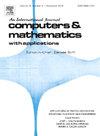High-order discretized ACMS method for the simulation of finite-size two-dimensional photonic crystals
IF 2.5
2区 数学
Q1 MATHEMATICS, APPLIED
引用次数: 0
Abstract
The computational complexity and efficiency of the approximate mode component synthesis (ACMS) method is investigated for the two-dimensional heterogeneous Helmholtz equations, aiming at the simulation of large but finite-size photonic crystals. The ACMS method is a Galerkin method that relies on a non-overlapping domain decomposition and special basis functions defined based on the domain decomposition. While, in previous works, the ACMS method was realized using first-order finite elements, we use an underlying hp–finite element method. We study the accuracy of the ACMS method for different wavenumbers, domain decompositions, and discretization parameters. Moreover, the computational complexity of the method is investigated theoretically and compared with computing times for an implementation based on the open source software package NGSolve. The numerical results indicate that, for relevant wavenumber regimes, the size of the resulting linear systems for the ACMS method remains moderate, such that sparse direct solvers are a reasonable choice. Moreover, the ACMS method exhibits only a weak dependence on the selected domain decomposition, allowing for greater flexibility in its choice. Additionally, the numerical results show that the error of the ACMS method achieves the predicted convergence rate for increasing wavenumbers. Finally, to display the versatility of the implementation, the results of simulations of large but finite-size photonic crystals with defects are presented.
有限尺寸二维光子晶体模拟的高阶离散ACMS方法
针对大型有限尺寸光子晶体的模拟,研究了二维非均质亥姆霍兹方程近似模分量合成(ACMS)方法的计算复杂度和效率。ACMS方法是一种基于非重叠域分解和基于域分解定义的特殊基函数的伽辽金方法。在以前的工作中,ACMS方法是使用一阶有限元实现的,而我们使用底层hp -有限元方法。我们研究了ACMS方法在不同波数、域分解和离散参数下的精度。此外,从理论上研究了该方法的计算复杂度,并与基于开源软件包NGSolve实现的计算次数进行了比较。数值结果表明,对于相关的波数域,ACMS方法得到的线性系统的大小仍然适中,因此稀疏直接求解是一种合理的选择。此外,ACMS方法仅表现出对所选域分解的弱依赖性,从而在其选择中具有更大的灵活性。此外,数值结果表明,随着波数的增加,ACMS方法的误差达到了预测的收敛率。最后,为了显示实现的通用性,给出了具有缺陷的大但有限尺寸光子晶体的模拟结果。
本文章由计算机程序翻译,如有差异,请以英文原文为准。
求助全文
约1分钟内获得全文
求助全文
来源期刊

Computers & Mathematics with Applications
工程技术-计算机:跨学科应用
CiteScore
5.10
自引率
10.30%
发文量
396
审稿时长
9.9 weeks
期刊介绍:
Computers & Mathematics with Applications provides a medium of exchange for those engaged in fields contributing to building successful simulations for science and engineering using Partial Differential Equations (PDEs).
 求助内容:
求助内容: 应助结果提醒方式:
应助结果提醒方式:


